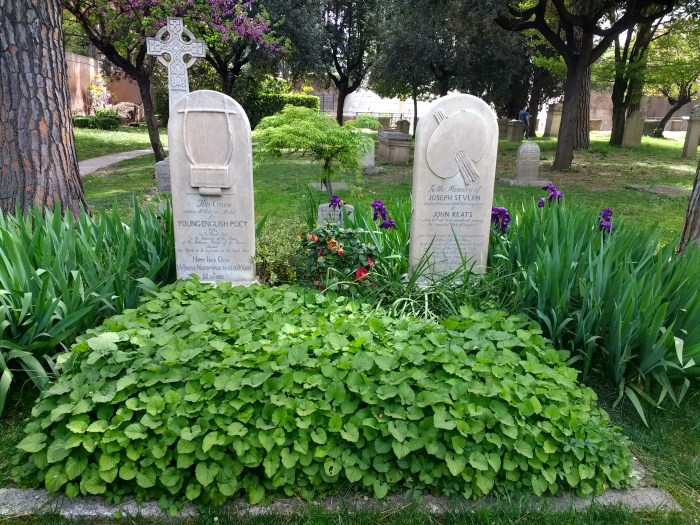
Located in Rome’s Testaccio district is Rome’s Protestant Cemetery where many distinguished figures through the ages are buried. The cemetery is most famous for being the resting place of the English poets John Keats and Percy Bysshe Shelley. Both poets died young. Shelley at 30 and Keats at only 25. Keats died in Rome in 1821 of tuberculosis and is buried next to his friend, the English painter Joseph Severn (who lived 58 years longer dying at the age of 84 in 1879), in the Parte Antica (Old Part) of the cemetery by the prominent Pyramid of Cestius, originally constructed in 18-12 BC as a tomb for Gaius Cestius who was a magistrate and member of the Septemviri Epulonum, one of the great religious corporations of ancient Roman priests.

The graves of poet John Keats (on the left) and his friend Joseph Severn
Shelley drowned off the Italian Riviera in 1822, just a year after Keats. Even stranger is the fact that a book of Keats poetry was found in his pocket when his body was washed up on the shore. His friends, the poet Lord Byron and the English novelist and traveller Edward John Trelawny, cremated his body on a beach near the Tuscan town of Viareggio. The ashes were then sent to the British consulate in Rome who transferred them to the Protestant Cemetery. Shelley’s grave is located in the Zona Vecchia (Old Area) part of the cemetery in the row at the very back. His epitath reads, ‘Nothing of him that doth fade, But doth suffer a sea=change, In to something rich and strange’…

The grave of the 19th century English Romantic poet Percy Bysshe Shelley
Directly facing Shelley’s grave is the small grave of the American Beat era poet Gregory Corso who died in 2001. His epitath reads, Spirit is life, it flows thru the death of me, endlessly like a river, unafraid of becoming the sea.

The Grave of the American beat poet Gregory Corso
Elsewhere in the cemetery are the tombs of the grandson of the poet William Wordsworth and the only son of the German writer and poet Goethe. The cemetery contains the grave of the uncle of Edvard Munch, Peter Andreas Munch, who was a historian. One can also find the graves of the 20th century Italian poets Dario Belleza and Amelia Rosselli. One of the principle artists of the Italian post-WW2 Arte Povera art movement, Jannis Kounellis, was buried here last year. The graves of the 19th century English sculptors, John Gibson and Richard James Wyatt, who were both students of the Italian sculptor Antonio Canova, are both located in this cemetery.

The tomb of the 19th century English sculptor John Gibson
The grave of the Italian philosopher and one of the founders of the Communist Party Of Italy, Antonio Gramsci, can be found here. He was imprisoned in 1926 during Benito Mussolini’s Fascist regime. Whilst in prison he wrote the seminal Prison Notebooks between 1929-35, which were inspired by Marxist theory and by the writings of figures such as Niccolo Machiavelli and Vilfredo Pareto. In 1935 he was released from prison due to deteriorating health and died two years later in 1937.

The grave of the Italian Marxist philosopher and Communist Party of Italy founder Antonio Gramsci
One of the most prominent graves in the cemetery is that of the Italian surgeon and humanist Giovanni Ceccarini, which reigns majestically in full Neo-Classical opulence and glory.

The lavish neo-classical tomb of the Italian surgeon and humanist Giovanni Cecarrini
Visiting this cemetery is definitely worth the trip. Especially on a sunny and cloudless day. It is one of the most beautiful and peaceful cemeteries I have ever visited. Some cemeteries can be a sombre and oppressive experience but not this one. Moreover, it is not an overvisited place like many of Rome’s other landmarks. There is no fee for visiting but at least a 3 euro donation is recommended in order to maintain the cemetery.
By Nicholas Peart
(c)All Rights Reserved